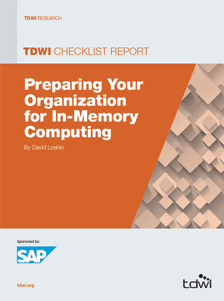
TDWI Checklist Report | Preparing Your Organization for In-Memory Computing
August 7, 2014
The “decision support system” concept that emerged more than 20
years ago has evolved into the modern data warehouse (DW) that is
now ubiquitous in any enterprise information architecture. However,
early designers, driven by the need to preserve online transaction
processing (OLTP) response times, made a practical engineering
decision to replicate transaction data to a segregated platform that
would house the reporting and business intelligence (BI) systems.
The conventional wisdom for BI and analytics insists on an intricate
infrastructure that iteratively extracts source data sets, applies
transformations, and loads the data into a segregated environment.
The benefit of system segregation to protect performance is offset
by the overhead and complexity associated with data integration,
which in turn has contributed to skyrocketing costs for acquiring and
maintaining the data warehouse ecosystem’s hardware and software.
Fortunately, in-memory database management systems promise
accelerated application performance balanced by increased
systemic simplicity. Combining alternative storage layouts with
in-memory processing allows applications to take advantage of
efficient use of available memory and reduce or even eliminate the
data latencies typically associated with significantly slower disk-based
storage media.
If reporting and analytics systems are still dissociated from data
sources, the performance enhancements gained by keeping the data
in main memory diminish as extraction and loading latencies are
reintroduced. However, as RAM and cache memory costs plummet and
massive multiprocessor systems enter the mainstream, it makes sense
to leverage in-memory computing systems such as SAP HANA to fully
integrate transaction processing, operational processing, and reporting
and analytics within the same in-memory platform.
This TDWI Checklist Report will help your organization prepare for
in-memory computing by discussing how it improves application
performance. In-memory computing enables the peaceful coexistence
of transaction processing and analytics without demanding data
extraction, transformations, rampant replication, and heterogeneous
computing platforms. We examine the impact of in-memory computing
on the corporate data footprint and how the information technology
landscape is made simpler.
A transition to in-memory computing makes information management
easier by freeing hardware and staff resources for productive use,
inspiring disruptive innovation that enables easier application
development, improved user experience, and general increase in
corporate value.